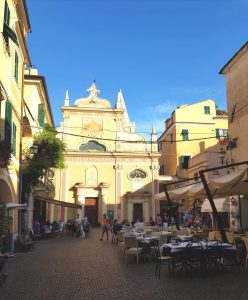Italian Food Snobbery and love for tradition. Reflections on Italian cuisine and food culture after a year living in northern Italy.

Italian food snobbery and love for tradition: Reflections on Italian cuisine and food culture after a year living in northern Italy
Paulina Chuchala
Before I moved to Italy, I thought of it as a super fancy place where the basic ingredients were celebrated with piety. I never thought of it only in terms of pasta and pizza. After visiting and working in many Italian restaurants around the world, I always hugely admired the variety of dishes that are difficult to get your head around.
I was not far from being completely wrong. It is incredible how well-educated Italians are when it comes to their cuisine. It doesn’t matter where you come from, what your educational background is, or what you do for a living. Everyone here has a Ph.D. in Italian cuisine. Plus, it’s a great conversation starter that will have you speaking with any stranger for as long as you want.
Not being Italian, I’m not used to hearing men speak about food. Here, it is commonplace to hear 20-year-olds conversing about how to best prepare a dish. Sharing your foreign eating habits is often met with incredulous looks and astonishment. I have been working very hard to adjust to the uncompromising customs around food since I am the one who decided to move here. However, Italians are not very forgiving if you do something that goes against set traditions. The pride of their rich culture makes it very difficult for them to accept alterations, or as I thought, improvements, to their way of life.
Breakfast
Let’s start with the most important meal of the day which here – surprise, surprise – is not breakfast.
Here’s a tip: close the door to the kitchen and put the ventilator on when making yourself something to eat in the morning. Shouting and screaming from my bedroom is something that I am very used to hearing when I am trying to make myself breakfast. The smell of fried bacon and eggs makes my boyfriend anguished. It also makes other Italians twitch when I speak about what I ate in the morning.
I think we will be never able to surmount the difference when it comes to our breakfast preferences. It is a rather difficult task to find a brunch or breakfast place with trendy, European favorites, such as chia pudding, avo on toast, or some type of vegan/vegetarian variation of a full English breakfast. I was once watching James May’s cooking show, where he was preparing breakfast staple dishes. My boyfriend couldn’t believe that someone would eat haddock with rice for breakfast or brunch.
Italians eat breakfast, but from a dietician’s perspective, their breakfast couldn’t be called a nutritionally dense meal. Let me explain to you why. Usually, for breakfast, you would be served a couple of biscuits, a plain croissant, or one filled with jam or chocolate. This would be usually accompanied by a coffee or a glass of juice. A meal like that would give you an insulin spike that will have your hands shaking 2 hours after eating it.
For any savory breakfast lovers out there, it is better to eat your egg, bacon, or beans on toast with the kitchen doors closed and in solitude or the company of very flamboyant and rebellious Italians.
Take away coffee: lungo, please!
A real pleasure in the morning when running errands or going to work used to be having a generous cup of coffee with me when walking. How lovely it is to walk to work in the early days of autumn when it starts to get colder outside and sip on a hot, frothy drink like a latte, cappuccino, or flat white.
I will have to stop myself here as this is something that will be hard to see in Italy. Even if you manage to convince someone to make you a big cup of coffee, the maximum you can count on is that it will be served in a very small takeaway cup. The same cup that big chain coffee shops outside of Italy use to serve espresso.
It is not surprising then that the first Starbucks was opened just a few years ago in 2018, in Milan. There are only 15 Starbucks around Italy, and another venue was supposed to be open in Rome but apparently, coronavirus put a spanner in the works. Considering that there are 132 Starbucks outlets in neighboring France, this says a lot about how Italians want to drink their beloved beverage.
Coffee is to be consumed either standing by the bar or sitting. Walking and drinking are not socially acceptable as the size of coffee does not require you to stay longer in the bar. That’s why cafés here are not very popular. You do not take your laptop to a coffee shop to stay there for hours on end to work, study or just to browse the Internet outside of your house, because your WiFi doesn’t work.
When you have already walked with a coffee and received strange looks from passers-by, it is time for your colleagues to welcome you to work with an exasperated look. They would be probably thinking “foreigners, what do they know about drinking coffee?! It’s blasphemy! Horrible!” Especially if you were holding a Starbucks Venti (for those who don’t know the cup size in Starbucks – that is 591 ml of a coffee beverage).
My afternoon americano at work is already considered strange. If you ever find yourself in Italy, please remember that you will have to forget about flat whites, lattes, and so on. Or if you love them so much, you will just have to prepare them at home. Along with your breakfast.
Garlic: to eat it or not to eat it, that is the question!
An ingredient completely misunderstood by the rest of the world as typically Italian is garlic. We, non-Italians, live with the wrong conviction that when served garlic bread in a local Italian restaurant, the flavor of garlic is a truly Italian ingredient. We couldn’t be more ignorant.
Eating garlic, specifically having it on your breath lingering the day after, is something that is frowned upon at work and in social life. Food containing garlic is eaten only over the weekend, when professional relationships are limited to emergencies, and when you want to spend a quiet weekend in. It is considered really fastidioso [annoying]. Once, I was forced to sleep in a guest bedroom just because I had a very generous portion of bagna cauda – a Piedmontese specialty, type of salsa/dip made with loads of garlic that caused my boyfriend to have nausea by just staying next to me in bed!

Italians think of garlic as a flavour enhancer, not as an ingredient. This is why it is not consumed. When cooking, a whole clove of unpeeled garlic is thrown into a pan with oil, and it is removed after a few minutes, before it starts to cook. In this way, the oil used to fry the other ingredients in a recipe will have an extra depth of flavour. The same goes for meat and fish marinades. Using a whole garlic clove allows a cook to remove it easily from the dish and enhance the taste of the main ingredient.
Italians are so very aware of the after-taste of garlic that they modify non-Italian recipes that call for this ingredient. One of the most famous Italian recipe pages Giallo Zeffrano does not call for garlic in the Gazpacho recipe, even though the original Spanish recipe includes it. Diving deeper into the mystery of not using garlic, I also discovered that the rest of the world puts the ingredient in the list, where an Italian recipe does not require using garlic. For example, an Italian staple: ragù or as we like to call it Bolognese sauce on Italian websites does not include garlic in the ingredients. Any decent website in English, however, would mention using garlic in the first steps of cooking the sauce.
Italians are proud of their northeastern variant of garlic: Aglio di Resia. It is known for its sweeter taste and apparently, it is devoid of the acrid aroma that a typical Italian finds unbearable. But it is a regional specialty not available worldwide, and they like to keep it this way. Even though sometimes it feels that Italians are too boastful and borderline arrogant, I hugely admire their love for the tradition in the world where globalization has swept away these beautiful and quirky things that make each of us wonderfully unique.
Bibliography:
Aloise, L. (2021, July 10). Authentic Gazpacho Recipe – The Best Spanish Gazpacho. Spanish Sabores. https://spanishsabores.com/recipe-gazpacho-andaluz/
Balmer, A. The best spaghetti bolognese recipe. BBC Good Food. https://www.bbcgoodfood.com/recipes/best-spaghetti-bolognese-recipe
Giallo Zafferano. Ragu’ alla Bolognese. https://www.giallozafferano.com/recipes/Ragu-alla-bolognese.html
Lancia, L. (2014, July 17). Aglio e cipolla: come si usano in cucina. Agrodolce. https://www.agrodolce.it/2014/07/17/come-usare-aglio-e-cipolla-in-cucina/
Team World. (2021, May 16). Starbucks in Italia: dove si trova? A Milano Roastery e Frappuccino. https://www.teamworld.it/lifestyle/starbucks-italia-si-trova-milano-piazza-cordusio/
True Numbers. Quanti Starbucks ci sono in Italia? Soltanto 15. https://www.truenumbers.it/starbucks-in-italia/
Wall Street Italia. Starbucks. https://www.wallstreetitalia.com/trend/starbucks/







